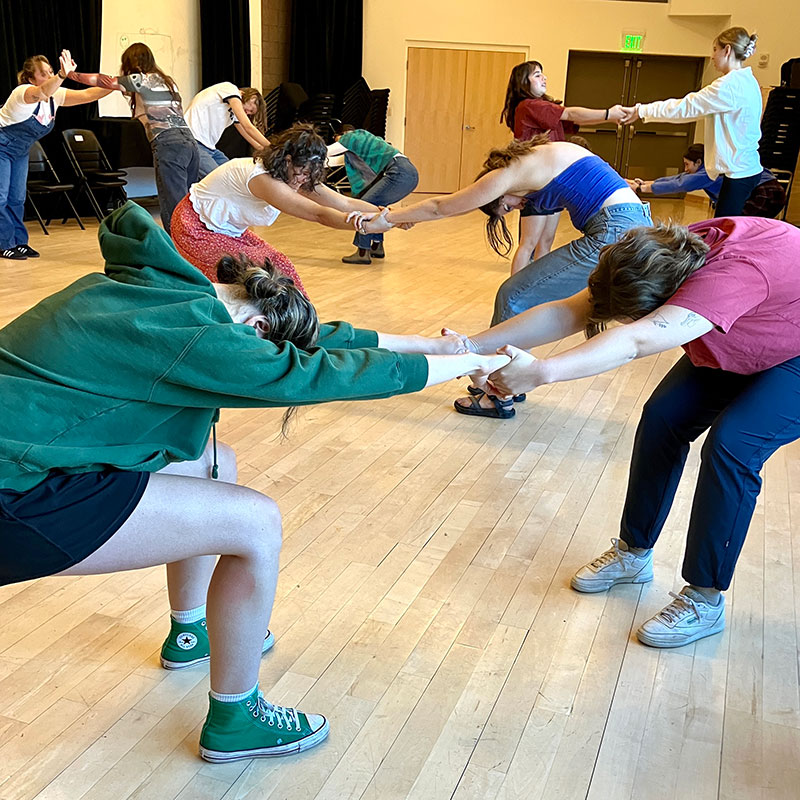While many CC students participate in convergence classes — combined class meetings between several CC classes — students in Moving Together: The Power of Art, Health, and Wellbeing had the opportunity to participate in combined class sessions with students from the University of Colorado, Colorado Springs, giving students from both schools the chance to discuss and practice the art of movement together.
The class traveled to the UCCS campus twice for creative workshops, where CC students got to collaborate on movement techniques with a UCCS undergraduate class of students within the Health Sciences Department.
“The workshops at UCCS were really interesting and fun,” says Andrew Han ’25. “Almost no one knew what to expect, so the UCCS students especially were surprised when we started doing intimate movement exercises. The exercises each had different metaphors that could be applied to healthcare and caregiving. It was interesting to see the UCCS students’ perception of CC and the Block Plan. Their classes seemed far more focused on lecture, and had less interdisciplinary aspects than CC.”
While the two schools are less than five minutes apart, students don’t always get the chance to collaborate together, making this class even more special.
“Collaborating with the UCCS class was a unique opportunity to engage with students we normally do not work with,” says Haley Strom ’24. “Our class had a strong sense of community, and it felt nice to share our traditions for connecting with each other with the UCCS students.”
“My favorite part of the class was the movement,” says Han, a Neuroscience major and Biochemistry minor. “It is just a fun way to express yourself artistically and to get the heart pumping.” Han is considering a career in the healthcare field, and he likes to dance, so he says that this class was the perfect fit for him.
“From my point of view, one has to take responsibility and be engaged as a partner in how one stays healthy,” says class instructor Suzanne M. Costello, a Theatre and Dance Department block visitor, who previously taught at CC in the 1980s. “This changes the concept from disease intervention to wellness engagement, so the thought of how to take care of ourselves before there is a problem.”
Costello rarely lectured in the class, instead choosing to focus on movement and class discussions, where students connected readings and discussions through movement.
“For example, we did mutual support activities where we pulled/pushed on a partner to keep ourselves supported, or an activity where we moved together with a partner and neither of us were leading, but we did what was mutually decided on non-verbally,” Han says.
“One thing I appreciated about this class is how we sat in a circle,” says Strom, a Psychology major and Journalism minor.” It is uncommon to be in a space that is built for making eye contact with every student. When we were not dancing, we were often engaging in self-reflection and sharing out. This reflection took many forms: journaling, drawing, poetry-writing, and even choreographing performances that reflect our personal stories.”
Costello taught students different self-care practices they could engage with as ways for them to take responsibility for their own wellness and health, both physical and mental. Students also discussed how the principles of arts, health practices, and wellbeing relate to other disciplines, such as education, economics, and psychology.
“Exploring the power of movement and touch relates to any other discipline that requires interpersonal interaction,” says Jimmy O’Connell ’27. “Education, health sciences, and even economics in some instances require intimacy skills that are becoming more and more underdeveloped. Cultivating our sense of connection and meaningful relationships will lead to much healthier work environments and increase patient satisfaction, which research has already shown.”
The class was diverse in terms of class year and major, ranging from first-year students to seniors, and majors all the way from Molecular Biology to Sociology and Anthropology to Computer Science. This allowed students from all backgrounds to practice and discuss wellness engagement.
“Movement explorations, especially those that involve collaboration, are relevant to every discipline,” says Strom, who took the class because she is interested in alternative forms of therapy and enjoys dancing, specifically swing dancing. “While we normally practiced self-expression through sharing ideas through verbal communication, using movement is an opportunity to utilize a more spontaneous form of expression—and encourages students to observe rather than judging to respond immediately.”
Costello also had students discuss the concept of empathy and how that shows up in the way students engage with the world.
“When we go to a physician or a therapist, we are asking them to care about us, which is an empathetic engagement,” Costello says. “It’s always interesting to me that we have to think about, consciously, how do we practice empathy towards one another. And if we are in a caring profession, we have to think about how we demonstrate that we care about one another. For example, how do I know that when I go to this nurse practitioner, that he or she seems interested in me?”
Strom’s favorite part of the class was the time dedicated to sharing their self-reflections. “I am accustomed to professors asking how I am doing at the start of class, but less so to being in an academic space like this where we actually listen to how people respond,” she says. “This part of the class has been crucial to not just knowing the people I am sitting next to, but also to feeling excited about sharing ideas.”
Costello hopes that students left the course with a better understanding of wellness and how to take care of themselves, both mentally and physically, which is a goal that seems to have been achieved, as multiple students reflected on the positive experiences they had learning the mindfulness and wellness exercises.
This is the first time the class was offered at CC, and it was such a success that Costello was asked to teach it again next year in Block 3.



